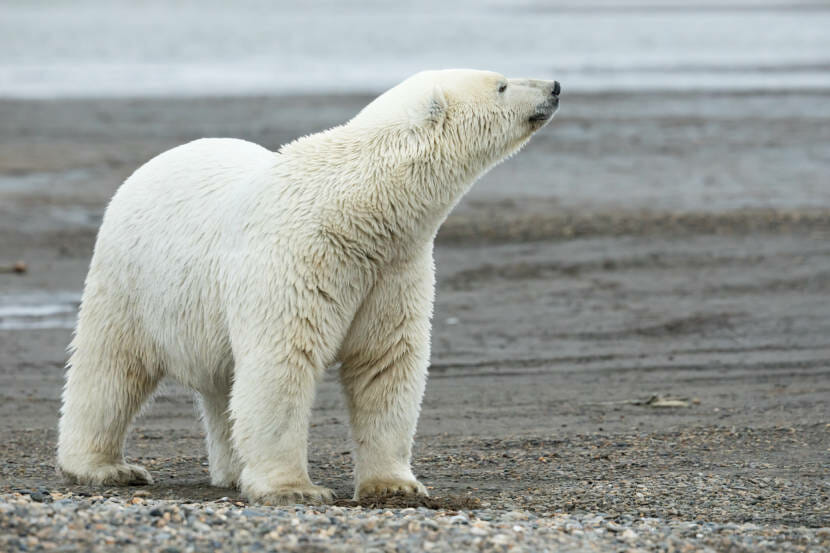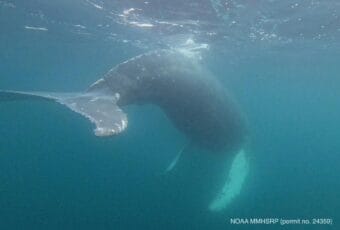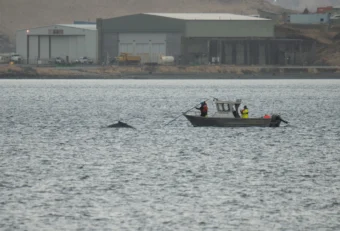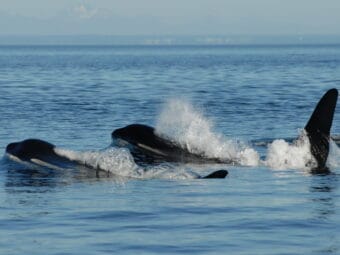
The U.S. Fish and Wildlife Service is beginning its next review of polar bears’ status under the Endangered Species Act.
The review, which the Fish and Wildlife Service conducts every five years, could result in polar bears being “uplisted” to endangered, with further protections, or de-listed altogether. And of course, they might just stay right where they are, listed as threatened and still protected under the Endangered Species Act and other laws.
Erin Knoll is the threatened and endangered species coordinator for the Fish and Wildlife Service’s Alaska region. While polar bears’ status as a threatened species often draws a lot of attention, Knoll says it’s too early to say what recommendations might come out of the review or what implications they might have.
Listen here:
The following transcript has been lightly edited for clarity.
Erin Knoll: So every five years, we review the status of listed species. So we are looking for information, any new information since the last review, which was done in 2017. And that information includes information about the species, its habitat and any threats that it might face, or it does face, since the last review. And we’re looking for information from the public, you know, any researchers that are out there. We have already coordinated with partners and reached out to them, including the state of Alaska, tribal governments, corporations, researchers at universities and other countries, to see if they have any new information.
Casey Grove: Gotcha. So it’s kind of an open call to people, but there’s also coordination and sort of some outreach involved there?
Erin Knoll: Yes, we send out letters to our existing partners, but then we want to keep it open, and we don’t want to limit ourselves. So we reached out. It goes out to the general public too.
Casey Grove: So, understanding that this is kind of a long-term process, what, in the future, are the possible implications of polar bears being uplisted to endangered, if that were to happen?
Erin Knoll: So right now, we’re working on this five-year status review. And it’s important to understand that a status review only results in a recommendation. And that recommendation could be a recommendation to uplist to endangered or to downlist, or in this case, delist. If the recommendation is to uplist, we would go through the rulemaking process. So we would write a proposed rule, which would then get published in the Federal Register. So now we’re talking like a couple years out, and then that proposed rule would result in a 60-day comment period for the public, at a minimum. And once that comment period closes, we would review and consider all public comments prior to finalizing a rule. So when polar bears were first listed as threatened, we also published a special rule called a 4D rule. And that provides them protections very similar to what they would have if they were to be uplisted as endangered. If they were to be uplisted as endangered, we would review our conservation management plan and see if there were any additional measures that would be needed to continue to conserve polar bears. But as they’re currently listed as threatened, they receive almost the same protections as they would if they were to be uplifted to endangered.
Casey Grove: It’s probably important to point out that the Endangered Species Act isn’t the only thing that affords protections to polar bears, right? There are other laws, and what are those? And how do those compare to the Endangered Species Act?
Erin Knoll: Yeah, so polar bears are also protected by the Marine Mammal Protection Act, and CITES, which is the Convention on International Trade of Endangered Species of Wild Fauna and Flora. And it’s really the Marine Mammals Protection Act that provides the polar bears with a lot of protections. But the Endangered Species Act does give us additional flexibility to work with states and provide funding for listed species. It also directs us to work with federal agencies that authorize, fund, permit and carry out projects to ensure that those projects minimize impacts to listed species, like the polar bear. And then we can also work with private landowners to help with any listed species conservation.
Casey Grove: Okay. I have to ask, because I think there’s been a lot of attention on polar bears as a victim of climate change, in that, it’s pretty well established that fossil fuel emissions have caused global warming, which has melted sea ice and affected polar bears pretty negatively. Is there any way, at this point, of saying even hypothetically that an endangered listing for polar bears might have an impact on fossil fuels — either the fossil fuel industry or regulations on the use of fossil fuels?
Erin Knoll: So in the 2008 listing decision that we published, listing polar bears as threatened, we did recognize that loss of sea ice habitat due to human-induced climate change is the primary threat. However, under the Endangered Species Act, we don’t have the authority to regulate those greenhouse gas emissions. And similarly, in the listing rule, we noted that there wasn’t a regulation at the national or international level that directly and effectively addressed the primary threat to polar bears, which is range-wide loss of sea ice habitat. And this still holds true today. So really, we would just continue with what we’re currently doing, which is continue to work with partners and federal agencies that permit, fund and carry out projects in Alaska to minimize any impacts to polar bears in their habitat.
Casey Grove: Is it fair to say that polar bears get a lot of attention as a threatened species?
Erin Knoll: Yes. Polar bears are what we call a “charismatic megafauna.”



